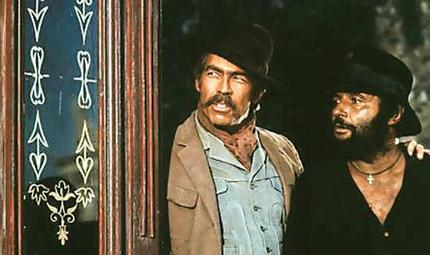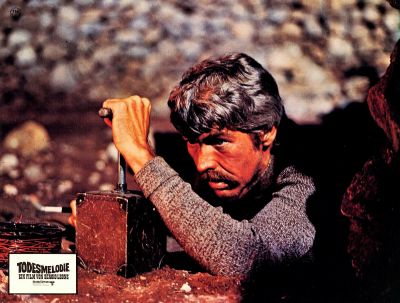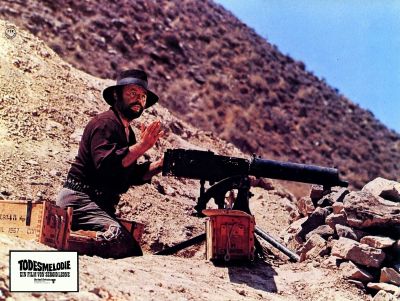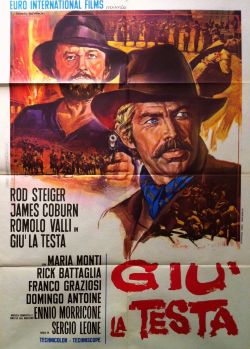A Fistful Of Dynamite Review by J.D.
Review of A Fistful Of Dynamite (1971) aka Giù la testa / Duck, You Sucker / Once Upon a Time... the Revolution;
Now, although us fans of the genre may disagree on particular film, it's pretty much unanimous that director Sergio Leone was best known for the ‘Dollars trilogy’, the films that made Clint Eastwood an international star, as well as kicked of the Italian western craze that was to last about a decade. After the trilogy, he went on to make two more westerns. In 1968, it was Once Upon a Time in the West, with Charles Bronson and Henry Fonda, one of my all-time favorite movies. In 1971, he made one more, about the Mexican revolution. Depending on when and where you saw it, it was called Giù la testa (‘Keep your head down’) in Italy, Once Upon a Time… the Revolution, in France, in the UK, it was A Fistful of Dynamite, and in the U.S., it was Duck, You Sucker, and when that title did poorly, it was changed to A Fistful of Dynamite.
This is definitely a political film… Leone’s take on the concept of revolution, inspired by both the ‘68 student uprisings in Paris, as well as his distaste for the way the Mexican revolution was portrayed in cinema up until that point, quite romanticized. It opens with a quote from Mao Tse-tung, which not surprisingly, was removed from the U.S. version:

The film stars American actors James Coburn and Rod Steiger. Coburn plays an Irish revolutionary named John Mallory, who has a taste for blowing things up. Steiger plays Mexican bandit Juan Miranda. Together they eventually conspire to rob a bank. The bank turns out to not be a bank, but a prison holding political prisoners. Juan unwittingly becomes a hero of the revolution, after liberating the prison in his search for loot.
On deeper level, there is much to say about the cost of revolutions and the toll it takes on friends and families. Through flashbacks, we see back to a betrayal of sorts in John’s days back in Ireland. The end of the movie gives us a flashback (which was trimmed to 30 seconds in the American cut) in which it puts John’s other flashbacks in a completely different context. So, unlike many westerns, there is a depth and substance to this film, as well as an emphasis on character development. There are many scenes that evoke other historical moments, such as the mass slaughters of Jews in WWII. The political messages were quite apparent, especially that revolution is not something to be romanticized. It is ugly, and takes a staggering toll on humanity.

And now, the review… at the time I saw this film, MGM hadn't released it in the US, so I had to get it from the UK. There was an excellent restoration job done on this film, the colors and sounds are fantastic, and the picture is very clear. It is also noteworthy because this version has the 22 minutes restored that were cut from the US release. If you know anything about Leone, his films tend to be quite long, and by the time they make it to the US, are usually edited beyond what he would have intended. I liked this movie. Coburn is great, kind of in a laid back humorous way, unlike Eastwood’s silent ‘Man with No Name’. Although he's often been criticized for his performance in this film, I think Steiger was awesome and intense. When you watch, at first you wonder if he is overacting, but then as the character develops, you see that isn’t the case. He succeeds in making a riff-raff of a human being into a likeable, emotional human character, and the events that Juan and John go through together have changed them very much by movie’s end. Steiger was surprisingly really convincing as a Mexican, not the stretch of the imagination of, let’s say, Marlon Brando in ‘Viva Zapata’.
One common criticism of Leone’s films is pacing. It is not unusual to have a scene consisting of a character’s silent face for several minutes. Often, it adds to the suspense, but sometimes in this film it slows it down. There are a few moments where the typical ‘Leoneisms’, such as the extreme closeups of eyes or mouths, sudden camera zooms, etc. start to almost become a cliche at this point. Yet there is also some AMAZING cinematography here as usual, often involving wide shots or interesting lighting techniques. A favorite one for me involved a scene where Coburn’s character witnesses something rather disturbing, and at the end of the scene, we see his still, stoic face slowly fade to shadow.

The score by Ennio Morricone is excellent, albeit quite strange at times. The release also comes with a great bonus disk featuring several interesting documentaries. It is also worth noting that many other Italian westerns at this time were becoming more political, such as Damiano Damiani’s excellent A Bullet for the General. This is known as the second period in Italian westerns. The first would have been primarily the emergence of the Italian style, think Fistful of Dollars or Django. the second phase was more political, in part in influence of the world’s events at the time, as well as a soul-searching in Italy regarding its flirtation with Fascism during WWII. The third period, which was early-mid 70’s was the comedy-western, a bit less serious and self parodying. These are best exemplified by the ‘Trinity’ series starring Terence Hill.
This was my least favorite of the Leone westerns because the pacing felt a bit slow to me at times. yet still it was still a very good movie. If you can get a hold of the restored version, I would recommend it, but I would also recommend seeing the Dollars trilogy and Once Upon a Time in the West before seeing this film, for I think you’ll appreciate it more after understanding Leone’s style.
This article is part of the A Fistful of Pasta archive




